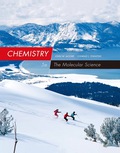
Concept explainers
(a)
Interpretation:
The enthalpy change for breaking of all bonds present in all reactants of given reaction has to be calculated.
(a)
Answer to Problem 62QRT
The enthalpy change value for breaking of bonds for bromine reaction is
Explanation of Solution
The reactions of molecular hydrogen with bromine and iodine are as follows,
Above both reactions, involves breaking of one
(b)
Interpretation:
The enthalpy change for forming of all bonds present in all products of given reaction has to be calculated.
Concept Introduction:
Refer part (a).
(b)
Answer to Problem 62QRT
The enthalpy change value for forming of bonds in bromine reaction is
Explanation of Solution
The reaction of molecular hydrogen with fluorine and chlorine is as follows,
Above both reactions involve formation of 2 hydrogen-halogen bonds. The
(c)
Interpretation:
The enthalpy change given reaction has to be calculated.
Concept Introduction:
The enthalpy change in a system
Where,
(c)
Answer to Problem 62QRT
The enthalpy change value for bromine reaction is
Explanation of Solution
The reactions of molecular hydrogen with bromine and iodine are as follows,
The enthalpy change value for each reaction is determined by considering the formula,
(d)
Interpretation:
From the two given reactions, the exothermic reaction has to be identified.
Concept Introduction:
Enthalpy is the amount energy absorbed or released in a process. Under constant pressure conditions the enthalpy change will be equal to molar q.
Exothermic reaction: Exothermic reactions are those in which evolution of heat takes place during any
Endothermic reaction: Endothermic reactions are those in which heat is absorbed during any chemical reaction. In such type of reactions, external energy is needed.
(d)
Answer to Problem 62QRT
The reaction between molecular hydrogen and bromine is more exothermic than the other one.
Explanation of Solution
The reaction of molecular hydrogen with bromine is more exothermic since
Want to see more full solutions like this?
Chapter 4 Solutions
EBK CHEMISTRY: THE MOLECULAR SCIENCE
- When 2.50 g of methane burns in oxygen, 125 kJ of heat is produced. What is the enthalpy of combustion per mole of methane under these conditions?arrow_forwardHydrazine, N2H4, is a colorless liquid used as a rocket fuel. What is the enthalpy change for the process in which hydrazine is formed from its elements? N2(g)+2H2(g)N2H4(l) Use the following reactions and enthalpy changes: N2H4(l)+O2(g)N2(g)+2H2O(l);H=622.2kJH2(g)+12O2(g)H2O(l);H=285.8kJarrow_forwardThe enthalpy change for the reaction of hydrogen gas with fluorine gas (o produce hydrogen fluoride is 542 U for the equation as written: mg src=Images/HTML_99425-10-41QAP_image001.jpg alt="" align="top"/> l type='a'> What is the enthalpy change per mole of hydrogen fluoride produced? Is the reaction exothermic or endothermic as written? What would be the enthalpy change for the reverse of the given equation (that 1%, for the decomposition of HF into its constituent elements)?arrow_forward
- Hydrogen, H2, is prepared by steam reforming, in which hydrocarbons are reacted with steam. For CH4, CH4(g)+H2O(g)CO(g)+3H2(g) Calculate the enthalpy change H for this reaction, using standard enthalpies of formation.arrow_forwardThe equation for the fermentation of glucose to alcohol and carbon dioxide is: C6H12O6(aq) 2C2H5OH(aq) + 2CO2(g) The enthalpy change for the reaction is 67 kJ. Is this reaction exothermic or endothermic? Is energy, in the form of heat, absorbed or evolved as the reaction occurs?arrow_forwardFor the reactions of molecular hydrogen with fluorine and with chlorine: (a) Calculate the enthalpy change for breaking all the bonds in the reactants. (b) Calculate the enthalpy change for forming all the bonds in the products. (c) From the results in parts (a) and (b), calculate the enthalpy change for the reaction. (d) Which reaction is most exothermic?arrow_forward
- Which of the enthalpies of combustion in Table 5.2 the table are also standard enthalpies of formation?arrow_forwardWith a platinum catalyst, ammonia will burn in oxygen to give nitric oxide, NO. 4NH3(g)+5O2(g)4NO(g)+6H2O(g);H=906kJ What is the enthalpy change for the following reaction? NO(g)+32H2O(g)NH3(g)+34O2(g)arrow_forwardAlthough the gas used in an oxyacetylene torch (Figure 5.7) is essentially pure acetylene, the heat produced by combustion of one mole of acetylene in such a torch is likely not equal to the enthalpy of combustion of acetylene listed in Table 5.2. Considering the conditions for which the tabulated data are reported, suggest an explanation.arrow_forward
- The enthalpy change for the following reaction is 393.5 kJ. C(s,graphite)+O2(g)CO2(g) (a) Is energy released from or absorbed by the system in this reaction? (b) What quantities of reactants and products are assumed? (c) Predict the enthalpy change observed when 3.00 g carbon burns in an excess of oxygen.arrow_forwardYou discover that you cannot carry out a particular reaction for which you would like the enthalpy change. Does this mean that you will be unable to obtain this enthalpy change? Explain.arrow_forward9.41 Under what conditions does the enthalpy change equal the heat of a process?arrow_forward
 Chemistry: The Molecular ScienceChemistryISBN:9781285199047Author:John W. Moore, Conrad L. StanitskiPublisher:Cengage Learning
Chemistry: The Molecular ScienceChemistryISBN:9781285199047Author:John W. Moore, Conrad L. StanitskiPublisher:Cengage Learning General Chemistry - Standalone book (MindTap Cour...ChemistryISBN:9781305580343Author:Steven D. Gammon, Ebbing, Darrell Ebbing, Steven D., Darrell; Gammon, Darrell Ebbing; Steven D. Gammon, Darrell D.; Gammon, Ebbing; Steven D. Gammon; DarrellPublisher:Cengage Learning
General Chemistry - Standalone book (MindTap Cour...ChemistryISBN:9781305580343Author:Steven D. Gammon, Ebbing, Darrell Ebbing, Steven D., Darrell; Gammon, Darrell Ebbing; Steven D. Gammon, Darrell D.; Gammon, Ebbing; Steven D. Gammon; DarrellPublisher:Cengage Learning Introductory Chemistry: A FoundationChemistryISBN:9781337399425Author:Steven S. Zumdahl, Donald J. DeCostePublisher:Cengage Learning
Introductory Chemistry: A FoundationChemistryISBN:9781337399425Author:Steven S. Zumdahl, Donald J. DeCostePublisher:Cengage Learning Chemistry & Chemical ReactivityChemistryISBN:9781133949640Author:John C. Kotz, Paul M. Treichel, John Townsend, David TreichelPublisher:Cengage Learning
Chemistry & Chemical ReactivityChemistryISBN:9781133949640Author:John C. Kotz, Paul M. Treichel, John Townsend, David TreichelPublisher:Cengage Learning Chemistry for Engineering StudentsChemistryISBN:9781337398909Author:Lawrence S. Brown, Tom HolmePublisher:Cengage Learning
Chemistry for Engineering StudentsChemistryISBN:9781337398909Author:Lawrence S. Brown, Tom HolmePublisher:Cengage Learning Chemistry: Principles and PracticeChemistryISBN:9780534420123Author:Daniel L. Reger, Scott R. Goode, David W. Ball, Edward MercerPublisher:Cengage Learning
Chemistry: Principles and PracticeChemistryISBN:9780534420123Author:Daniel L. Reger, Scott R. Goode, David W. Ball, Edward MercerPublisher:Cengage Learning





